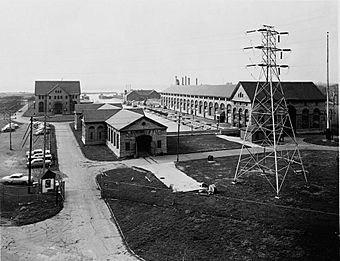Adams Power Plant Transformer House facts for kids
|
Adams Power Plant
Transformer House |
|

Adams Power Plant, with transformer house in left foreground
|
|
| Location | Niagara Falls, NY |
|---|---|
| Built | 1895 |
| Architect | McKim, Mead, and White |
| Architectural style | Beaux-Arts architecture |
| NRHP reference No. | 75001212 |
Quick facts for kids Significant dates |
|
| Added to NRHP | June 1, 1975 |
| Designated NHL | May 4, 1983 |
The Adams Power Plant Transformer House in Niagara Falls, New York is a very important historic building. It was built in 1895 and is a National Historic Landmark. This building is the only part left of the famous Edward Dean Adams Power Plant. This power plant was the first in the world to produce electricity on a very large scale using alternating current. The plant was named after Edward Dean Adams, a smart businessman who worked in the electricity field.
Contents
The Story of the Power Plant
Planning to Use Niagara's Power
Back in 1886, an engineer named Thomas Evershed had a big idea. He wanted to use the amazing power of Niagara Falls to make electricity. His plan involved building a special "hydraulic canal" and a long, brick-lined tunnel, about 7,500 feet (2,286 meters) long.
To make this happen, the Niagara Falls Power Company was created. Then, a new company called the Cataract Construction Company was formed. This company was led by Edward Dean Adams.
Finding the Best Way to Make Power
In 1890, Edward Dean Adams's company created a group called the International Niagara Commission. Their goal was to figure out the best way to use the power from the Falls. The group decided that electricity was the answer. However, they couldn't agree on the best way to produce it.
In 1892, a scientist named George Forbes joined as a special advisor. By May 1893, he convinced the company to build a hydroelectric system. This system would use something called "polyphase alternating current."
Building the Giant Generators
The company Westinghouse Electric was chosen to build the huge generators. These generators would make 5,000 horsepower (about 3,700 kilowatts) of 25 Hz alternating current. Their design was based on the brilliant work of Nikola Tesla and Benjamin G. Lamme.
At the same time, the I. P. Morris Company from Philadelphia built the giant water turbines. These turbines were designed by a Swiss company named Faesch and Piccard.
The Plant Comes to Life
The Adams Power Plant officially started working on August 25, 1895. The special transformer house building was designed by a famous architecture firm called McKim, Mead, and White. Local limestone was used to build it.
The transformer house was built near the upper river. Below it were deep holes holding 21 generating units. Water from these generators flowed into a 7,000-foot (2,134-meter) tunnel. This tunnel carried the water under the city and back to the lower river. Building this tunnel was a huge and difficult project. It took over three years to finish and used more than 16 million bricks!
Powering Cities Far Away
The Niagara Power Station No. 1, as it was first called, eventually produced a massive 50,000 horsepower (about 37,000 megawatts) of electricity. It had 10 generators, each making 5,000 horsepower.
The electricity was first made at 2,000 volts for local use in Niagara Falls. Then, special transformers increased the voltage to 10,000 volts for medium distances. For longer distances, like to Buffalo, Lockport, and Tonawanda, the voltage was stepped up even higher to 20,000 volts! This plant was so successful that a second similar station was built in 1904. In 1927, the entire plant was officially named after Edward Dean Adams.
A Lasting Legacy
The original Westinghouse generators worked continuously in the transformer house for a very long time. They kept running until the plant finally closed in 1961. Newer, larger power plants like the Robert Moses Niagara Power Plant and the Lewiston Pump-Generating Plant took over its job.
The Adams Power Plant Transformer House is still recognized for its importance. It was added to the National Register of Historic Places in 1975. Then, it was named a National Historic Landmark in 1983. In 1990, it was also recognized as an IEEE Milestone for its engineering achievements. You can find it off 15th Street, just south of Buffalo Avenue, in the Niagara Falls National Heritage Area.
Gallery






